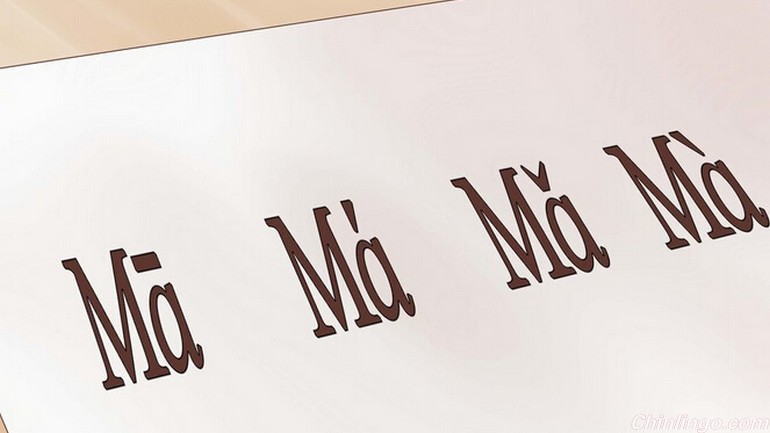
1 Practice using the four Mandarin tones.
Mandarin Chinese is a tonal language, which means that different tones can change the meaning of a word, even if the pronunciation and spelling are otherwise the same. It is absolutely essential to learn the different tones if you wish to speak Mandarin Chinese correctly. Mandarin Chinese has four main tones, as follows:
The first tone is a high, flat tone. Your voice stays flat, with no rise or dip in the way it sounds. Using the word "ma" as an example, the first tone is indicated using the symbol above the letter a: "mā".
The second tone is a rising tone. Your voice rises from a low to middle pitch, as if you were asking someone to repeat something by saying "huh?" or "what?" The second tone is indicated using the symbol "má".
The third tone is a dipping tone.The pitch goes from middle to low to high, like when you say the letter "B". When two third tone syllables are near each other, the second one retains its third tone sound while the first takes the sound of the second tone. The third tone is indicated using the symbol "mǎ".
The fourth tone is a lowering tone. The pitch goes rapidly from high to low, as if giving a command e.g. stop! Or as if you're reading a book and have come across something new and interesting and are saying "huh". The fourth tone is indicated using the symbol "mà".
Easy enough? If not, don't fret. It's definitely recommended to hear the tones demonstrated by a native speaker, since it's hard to get an idea of what they sound like purely through text.
2 Memorize simple vocabulary.
No matter what language you're learning, the more words you have at your disposal, the sooner you will become fluent. Therefore, the next thing to do is to memorize some useful Chinese vocabulary.
Some good vocabulary lists to start off with include: times of day (morning: zǎo shàng, afternoon: xià wǔ, evening: wǎn shàng) body parts (head: tóu, feet: jiǎo, hands: shǒu) food (beef: niú ròu, chicken: jī, egg: jī dàn, noodles: miàn tiáo) along with colors, days, months, transport words, weather, etc.
When you hear a word in English, think about how you would say it in Mandarin. If you don't know what it is, jot it down and look it up later. It's handy to keep a little notebook on you at all times for this purpose. Attach little Chinese labels (with the character, the pinyin and the pronunciation) to items around your house, such as the mirror, the coffee table and the sugar bowl. You'll see the words so often that you'll learn them without realizing it!
Although having a wide vocabulary is good, remember that in Mandarin, accuracy is more important. It's no good learning a word if you can't pronounce it properly, using the correct tone, as different pronunciations could have entirely different meanings. For example, using the wrong tone (using mā instead of má) could be the difference between saying "I want cake" and "I want coke" – two completely different meanings.
3 Learn how to count.
Luckily, the Mandarin numerical system is fairly straightforward and logical, and once you have learned the first ten numbers you will be able to count to 99.
Below you will find the numbers one to ten, written in simplified Chinese characters, followed by the Hanyu pinyin translation and the correct pronunciation. Make sure to practice saying each number using the correct tone.
One: written as (一) or yī, pronounced [eee]
Two: written as (二) or èr, pronounced [arr]
Three: written as (三) or sān, pronounced [saan]
Four: written as (四) or sì, pronounced [ssuh]
Five: written as (五) or wǔ, pronounced [woo]
Six: written as (六) or liù, pronounced [lee-yoe]
Seven: written as (七) or qī, pronounced [chi]
Eight: written as (八) or bā, pronounced [baa]
Nine: written as (九) or jiǔ, pronounced [jee-yo]
Ten: written as (十) or shí, pronounced [sh]
Once you have mastered numbers one to ten, you can continue counting in double digits by saying the number in the tens' position, then the word shi, followed by the number in the one's position. For example:
The number 48 is written as sì shí bā, literally meaning "four tens plus eight". The number 30 is written as sān shí, literally meaning "three tens". The number 19 is written as yī shí jiǔ, literally meaning "one ten plus nine" (however in most Mandarin dialects the initial yī is omitted from numbers in the teens, as it is deemed unnecessary)
The word for hundred in Mandarin is (百) or baǐ, so 100 is written as yī bǎi, 200 hundred is written as èr bǎi, 300 is written as sān bǎi, etc..
4 Learn some basic conversational phrases. Once you have a basic grasp of vocabulary and and pronunciation, you can move on to learning basic conversational phrases which are used in everyday Chinese speech.
Hello = nǐhǎo, pronounced [nee how]
What is your surname (family name)? = nín guì xìng, pronounced [neen gway shing]
What's your name? = nǐ jiào shén me míng zì[1]
Yes = shì, pronounced [sh]
No = bú shì, pronounced [boo sh]
Thank you = xiè xiè, pronounced [shie shie]
You're welcome = bú yòng xiè, pronounced [boo yong shee-e]
Excuse me = duì bu qǐ, pronounced [dway boo chee]
I don't understand = wǒ bù dǒng, pronounced [wuo boo downg]
Goodbye = zài jiàn, pronounced [zay jee-en]



 闽公网安备 35020302035673号
闽公网安备 35020302035673号
0 responses on "How to Learn Mandarin Chinese - Part 1 Mastering the basics"